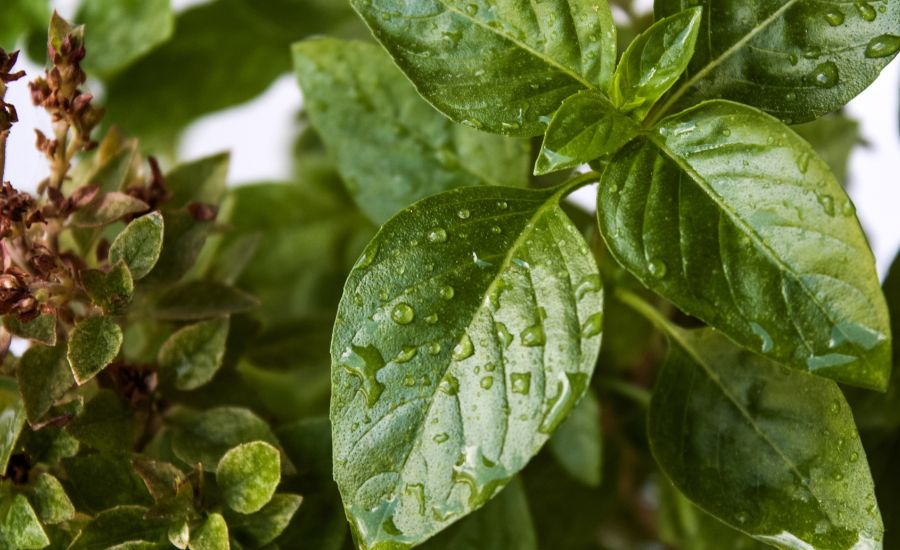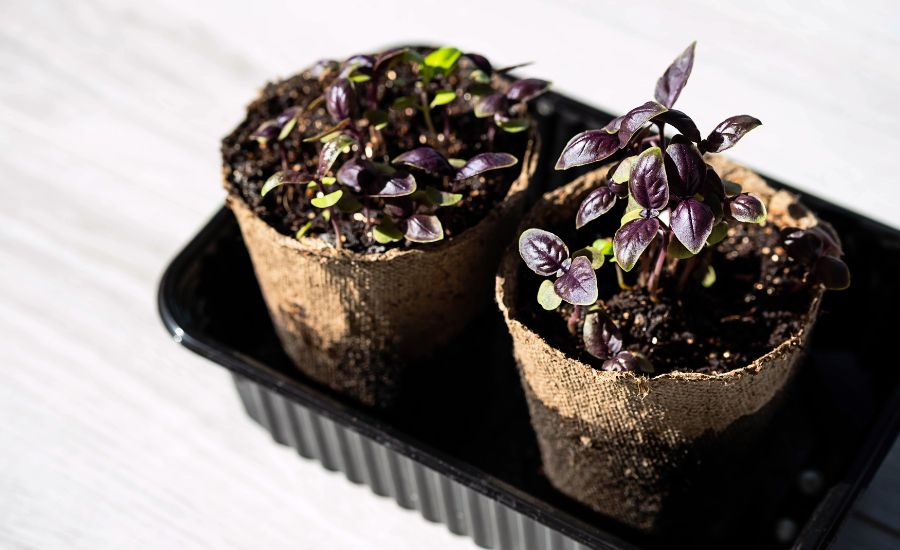When choosing the right kind of basil to grow, there are always some questions. How to compare purple basil vs green basil? Do you know the purple basil taste? Does this mysterious purple basil taste similar to a green one? How to cook it?
In this article, we are going to compare purple basil vs green basil and learn more about multiple basil varieties.

Contents
Purple basil vs green basil features
By nature, basil is a type of herb belonging to the mint family. People mostly grow it as a kitchen herb. However, basil can be also good for ornamental purposes.
Several basil species can be used in medicine.
To fully understand the features of purple basil vs green basil, find out more about the diversity in the world of basil.

What do you know about more basil varieties?
Basil plant has a lot of varieties. All these species can be defined into two general groups: green and purple basil.
Among purple basil species, there are multiple varieties and cultivars of common sweet basil. Moreover, some species can have both purple and green leaves.
These are some naturally purple basil species:
- African blue basil
- Holy sacred red basil
- Red Rubin basil
Several sweet basil cultivars have purple-colored leaves:
- Amethyst basil
- Dark opal basil
- Osmin basil
- Purple ruffle basil
Keep in mind that some varieties can normally have both purple and green color of leaves:
- Anise basil
- Holy basil
- Purple bush basil

Green and purple basil species are each full of unique features. Let’s take a closer look at the most popular kinds of basil!
Anise basil is also called licorice basil. Having a spicy and unique licorice flavor, this kind of basil can be an amazing accent in many dishes.
It is widely used as a Western analog of Thai basil.
African blue basil is a strong and tall kind of basil. It is a pungent and fragrant-rich basil type as it has a strong scent mix of camphor, cloves, mint, and peppers. Use African basil in meat dishes, rice, and vegetable recipes.
Cardinal basil has a very unique and bright appearance. You can differentiate it from any other kind of basil by its flowers by deep red clustered blooms.
Cardinal basil is also known for its strong and spicy flavor. It is a great flavoring ingredient in vinegar and many types of oils.
Cinnamon basil is a spicy and fragrant kind of basil plant. It is an interesting basil type that has reddish-purple stems and bright-green leaves. When mature, cinnamon basil produces nice pink flowers.
Cinnamon basil is one of the milder kinds of basil. As you can guess, this plant has a slight cinnamon flavor. Use cinnamon basil in fruit recipes and grilled vegetables, as well as in Asian cooking such as spicy marinades, rice dishes, or noodle salads.

Genovese basil is a classic type of Italian basil. This kind of basil is easy to recognize by the dark-green color of leaves that are flat and extra-large.
Genovese basil fits Italian dishes and pestos. Some cultivars can interchange Sweet and Genovese basil in the hybrid plant that has a milder and less aromatic flavor.
Greek basil is one of the smallest types of basil (the group of small basil varieties is also called dwarf basil). Because of its small size, Greek basil is very handy to grow in a pot.
Use Greek basil both as a seasoning and in sprigs. You can spice lots of Italian dishes with it, or make a tasty garnish to your favorite meat or pasta dishes.
Green ruffles basil is easy to define by its curly leaves. It is much taller than Sweet basil, as it grows up to 24 inches tall.
This is one of the mildest and the most delicate types of basil. You can add fresh leaves of this green basil to pasta dishes, or use them in salads to make a great texture accent.

Holy basil is also called tulsi basil. For Hinduism, this kind of basil is a sacred plant (hence it is named Holy basil). It is widely known for using both in medicine and in many Indian cooking recipes.
Raw Holy basil tastes bitter and is not pleasant to eat. The best idea is to eat Holy basil cooked, as many oriental recipes call for this ingredient.
Lemon basil is one more popular and widely grown kind of green basil. As you can guess from its name, fresh lemon basil has a nice lemony scent.
Lemon basil is good to use both fresh and as an ingredient of poultry marinades or grilled veggies. Add this basil to desserts, flavored teas, and refreshing drinks.
Lettuce basil has a telling name that describes its lettuce-like appearance. Like true lettuce, this kind of basil can be added to many fresh salads, sandwiches, and other dishes.
By origin, it is Italian basil, so it fits many Italian recipes. The large size of its leaves allows you to use it in lettuce wraps instead of true lettuce leaves. Having a mild and pleasant flavor, lettuce basil is a popular and versatile option in cooking.
Lime basil is less popular than lemon basil. Nevertheless, this basil is amazing as well. Its feature is a sweet and bright citrus flavor. Some gardeners grow both of these plants to cook with.
Purple basil (or Dark Opal basil) is definitely the most common type of purple basil. It is widely known for its leaves of stunning intense purple color. Unlike the tall amethyst variety, this purple basil variety is shorter in height.
Spicy globe basil is a dwarf variety of green basil. You can grow it in small containers for adding to salads, soups, and Italian pasta.

Summerlong basil isone of the dwarf types of basil. As you can guess from its name, it lasts longer in summer before the seeding period.
Sweet basil is the best-known kind of basil that you can easily get at all grocery stores. Since sweet basil leaves are dark green and glossy, you can differentiate them from other species. These leaves taste sweet and quite spicy.
If your recipe doesn’t call for a specific kind of basil, opt for sweet basil.
It is a favorite ingredient in many European dishes.
Thai basil is a strong, fragrant, and spicy purple basil variety. Being famous for its sweet licorice flavor, Thai basil fits many Asian dishes.
Among the purple basil varieties that are commonly spicy and strong, Thai basil is one of the spiciest. Thai basil is good for cooking as it keeps flavor in high temperatures.

What’s the difference between purple basil and regular basil?
Since both kinds of basil are amazing, they still have lots of different features. So, what are these differences?
Keep in mind that these types of basil are different in color, taste, and smell.
- As you can guess, the most obvious difference that opposes purple basil and green basil, they are opposite in color. But keep in mind that some basil hybrids can be both purple and green.
- You can easily feel the difference in taste. A feature of purple basil is a strong clove flavor while green basil has a milder and sweeter flavor. Since green basil is good for European cuisine, Asian hot and spicy dishes call for purple basil.
- As for the smell, green basil has a milder aroma. The smell of purple basil is pungent and fragrant.

Why is my purple basil turning green?
Purple basil is mainly famous for its unique color. In the stems and leaves of purple basil, there is a high content of purple pigment anthocyanin.
It brings an intense purple color to many vegetables and fruits.
In case your purple basil starts turning green, the answer is just a lack of anthocyanin in the plant. However, the reasons can be different:
#1. Lack of pigment
The anthocyanin level contains in the basil leaves gives them purple color. Strong light exposure increases the level of this pigment in plants. So, when sunlight exposure is not enough, the purple leaves start fading.
In addition, purple basil can fade due to seasonal changes, as there is much less sun in the autumn and winter seasons.
#2. Purple pigment inheritance
Sometimes purple basil turns green in case there is a genetic problem. According to a study by Purdue University, the pigment inheritance in basil is unstable. So, when buying purple basil seeds, you may have about a 34% probability of your purple basil being green!
#3. Hybrid coloring
Your basil plant can also be a hybrid that combines purple and green basil varieties, giving both green and purple colors to the plant. The color duality is a common case for such basil species as anise, purple bush, and sacred basil.

How to keep your basil purple?
Now, that you know the causes of purple basil turning green, here are a couple of hacks to prevent this problem:
#1. Provide enough light
Since lack of sunlight makes purple basil fade, provide your purple basil with enough of it. Regulate the growth light intensity and provide more light to keep basil purple.
#2. Change the location
For those who grow basil in pots, the simplest hack to keep basil purple is to place the pot in a more sunny place.

FAQ
Can I substitute purple basil with green basil?
Keep in mind that purple basil and green basil are totally different at several points.
First of all, they taste differently: unlike the sweet and mild flavor that green basil has, purple always has a spicy and clove-like flavor. This difference can affect the taste of the food significantly.
Remember that purple basil is not recommended to cook. When heated, purple basil turns black and looks unattractive to eat.
However, if you don’t mind trying something new when cooking salads, pasta, or any other dishes that call for fresh basil, you can try using some purple basil instead of green.
Is all purple basil edible?
Purple basil is fully edible and can be added to many types of dishes.
However, keep in mind that basil flowers are not safe to eat, as they accumulate pesticides that you spray the basil plant with.
What is purple basil good for?
Purple basil has a rich spicy taste and is a perfect option for Asian and Caucasian cuisine. Add it to meat dishes, vegetable salads, or spicy cheese varieties. Don’t forget that purple basil is an essential spice in oriental dishes.
Purple basil can also grow as an ornamental plant. Its deep purple color makes a great accent with many other colorful plants.
Final thoughts
Knowing all the features of purple basil and green basil, you can be sure what to choose and how to use your preferred type of basil. Try different species and you won’t regret any of them!
Read More: Does purple basil taste the same as green?


